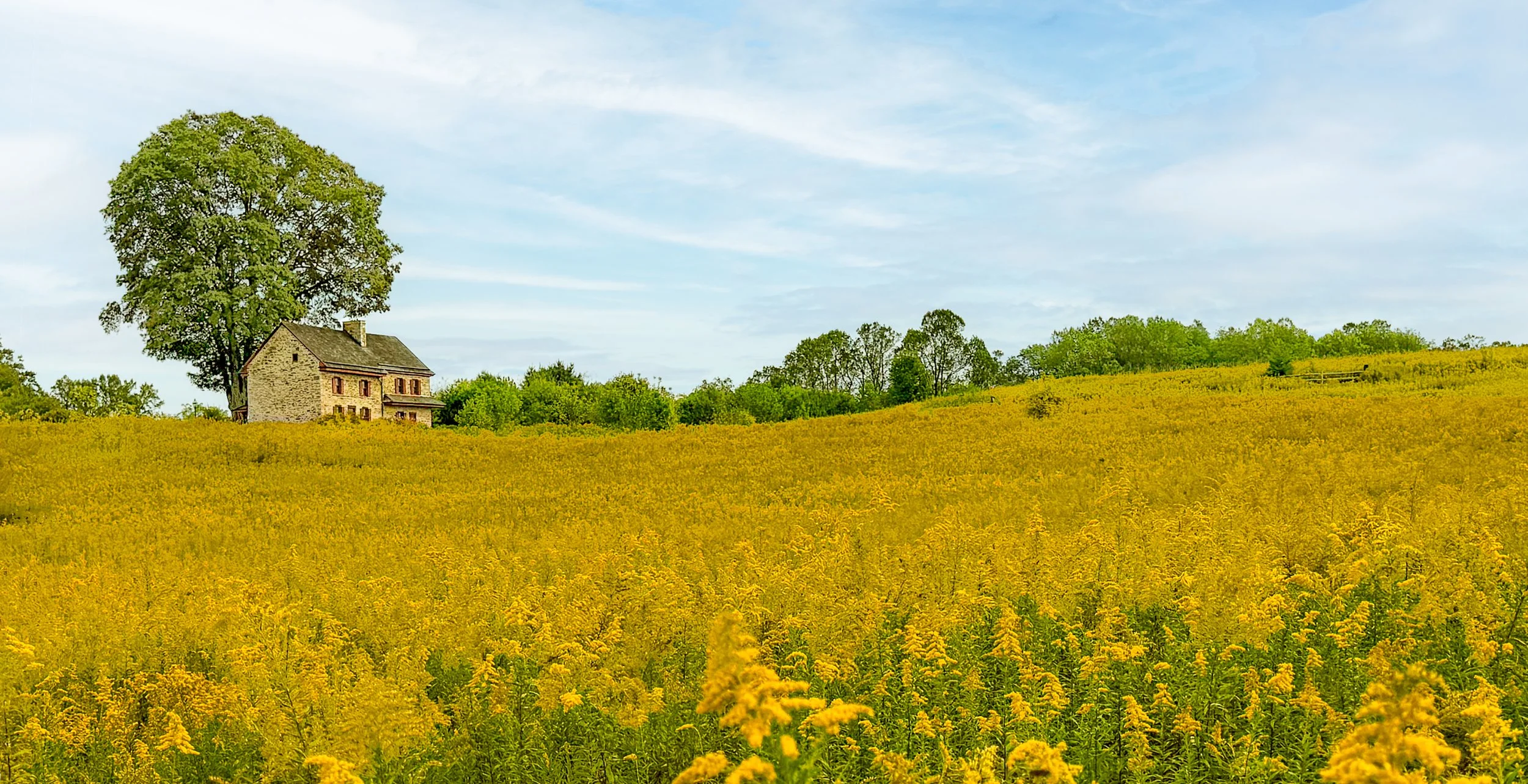Historic Quaker Houses of Chester County, PA
The Webb Farmhouse in Longwood Gardens
Built ca. 1734 and early 1800s:
Above: The Webb Farmhouse in Longwood Gardens. William Webb, Sr. built the eastern half (on the right) ca. 1734. The western half (on the left) was built ca. early 1800s. Image source: Lee J. Stoltzfus
Built for Quaker Farmer William Webb, Jr.
Who also was a Justice of the Peace and Politician:
Above: The Webb Farmhouse overlooking the Meadow Garden at Longwood Gardens. The house and meadow are icons of The Brandwine Aesthetic. Image source: Lee J. Stoltzfus
William Webb, Sr. built this house for his son William Webb, Jr. ca. 1734. The senior Webb was the son of Quaker immigrants Richard and Elizabeth Hoopes Webb, who emigrated from Gloucestershire, England in 1700. The family originally settled in Birmingham Township, Chester County. Elizabeth Webb was a Quaker minister. When she was a widow, she provided the land for constructing the Birmingham Friends Meetinghouse.
William Webb, Sr. purchased this land that is today’s Meadow Garden. He received 203 acres from George Harlan in 1713. He also acquired 301 acres from Samuel Pyle in 1725. While William Webb, Sr. owned this land he probably built this house as a home for his son, William Webb, Jr., shortly after William Jr.’s marriage to Elizabeth Hoopes in 1732.
William Webb, Jr. was active in the Quaker community. He served as clerk of the Monthly Meeting and was a recorder of marriages. He was a justice of the peace and served in the Assembly for several years.
Overlooking Longwood’s Meadow Garden:
Above: The Webb Farmhouse’s eastern half, shown here, is the house’s earliest section. William Webb, Sr. built this part of the house ca. 1734, with pent roofs, also called pent eaves.
Autumn Wildflowers in the Meadow Garden:
Above: Goldenrod and asters in the 86-acre Meadow Garden. Image source: Lee J. Stoltzfus
These rolling hills were once fertile farm fields owned by the Webb family. The founder of Longwood Garden, Pierre S. du Pont, purchased the Webb Farm for agricultural purposes. The farm fields eventually evolved into open spaces and wildflower meadows. In 2014 Jonathan Alderson Landscape Architects created this expanded Meadow Garden, while John Milner led the restoration of the farmhouse.
The Restored Webb Farmhouse:
Above: The restored kitchen in the Webb Farmhouse. In 2014 Architect John Milner restored this farmhouse to serve as a gallery space and museum. Image source: Lee J. Stoltzfus
Meadow Gallery in the Webb Farmhouse:
Above: The Webb Farmhouse features exhibits that interpret the Meadow Garden and the history of the farm. Image source: Lee J. Stoltzfus
The Other Quaker House in Longwood Gardens
The Peirce Farmhouse
Became the du Pont Home:
Above: Pierre du Pont, the founder of Longwood Gardens, transformed a Quaker farmhouse into his country home. Image source: 1730 house: Longwood Gardens YouTube, Peirce-du Pont House: Lee J. Stoltzfus.
In 1700, Quaker farmer George Peirce purchased 402 acres from William Penn’s commissioners. One of George’s sons, Joshua Peirce, built the brick farmhouse in 1730.
George Peirce’s twin great-grandsons, Samuel and Joshua Peirce, began planting an arboretum of specimen trees here in 1798. By 1850, the Peirce arboretum showcased one of the finest collections of trees in the U. S. Pierre du Pont purchased this farm in 1906 to preserve the trees.
The Meetinghouse of the Longwood Families
The Old Kennet Quaker Meetinghouse:
Above: Old Kennett Meetinghouse, Kennett Square near Longwood Gardens. Built between 1718 and 1731. Grave marker of William Webb, Sr. who built the Webb Farmhouse. Image sources: Top: TriCollege Libraries, Left: Lee J. Stoltzfus, Right: FindAGrave.com / L. Evans
The Webb and Peirce families built their farmhouses and their Kennett Quaker meetinghouse in the 1730s. This is one of the earliest surviving Quaker meetinghouses in the Delaware Valley. Webb and Peirce family members are buried here in the graveyard. Most gravestones are modest, reflecting Quaker ideals of simplicity.
Longwood Garden’s Quaker Families
During the Revolutionary War
Peace, Pacifism, & Anti-War Ideals:
Above: A Quaker dove of peace and the Old Kennett Meetinghouse. Image source: Lee J. Stoltzfus
Most Pennsylvania Quakers tried to stay neutral during the American Revolution, because of their anti-war ideals. Meanwhile, many of those Quakers were among the most prominent members of their communities. They held leading roles in commerce, local government, and education. But during the Revolutionary War many Quakers suffered persecution for holding firm to their pacifist convictions. Quakers were patriots of peace, as they are today.
The Old Kennett Meetinghouse
During the 1777 Battle of the Brandywine
“There was tumult without,
but Great Peace within.”
Above: The Old Kennett Meetinghouse near Longwood Gardens. Image source: KennettFriends.org
In September 11, 1777, the Battle of the Brandywine raged outside the Old Kennett Meetinghouse. Friends were meeting quietly inside the building during the battle. A British soldier opened the meetinghouse door to look inside, but the Quakers in the meetinghouse ignored his presence. A diary writer of that day explained that “there was tumult without, but great peace within.”
Links:










